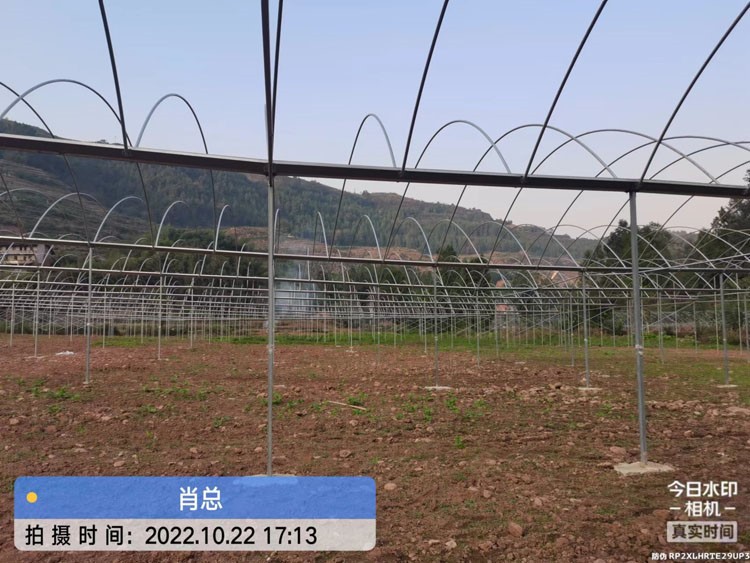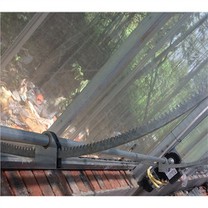Analysis of the advantages and characteristics of photovoltaic greenhouses
1. Brief introduction of photovoltaic agricultural greenhouses
Photovoltaic agricultural greenhouse is a greenhouse that integrates solar photovoltaic power generation, intelligent temperature control system, and modern high-tech planting. The greenhouse adopts a steel frame and is covered with solar photovoltaic modules, while ensuring solar photovoltaic power generation and the lighting requirements of the entire greenhouse crop. The power generated by solar photovoltaic can support the irrigation system of the greenhouse, supplement light for plants, solve the heating demand of the greenhouse in winter, increase the temperature of the greenhouse, and promote the rapid growth of crops.
Second, the advantages of photovoltaic agricultural greenhouses
Photovoltaic agricultural greenhouses are a new model of photovoltaic applications. Compared with building a centralized large-scale photovoltaic ground power station, the photovoltaic agricultural greenhouse project has many advantages:
1. Effectively alleviate the contradiction between man and land, and promote the sustainable development of social economy
The photovoltaic agricultural greenhouse power generation components use the roof of the agricultural greenhouse, which does not occupy the ground and does not change the nature of land use, so it can save land resources. It can play a good role in effectively reversing the large reduction of cultivated land under the situation of large population increase. On the other hand, photovoltaic projects are built on the original agricultural land, and the land quality is good, which is conducive to the development of modern agricultural projects, and the development of modern agriculture and supporting agriculture is conducive to the combination of secondary and tertiary industries and primary industries. And it can directly increase the economic income of local farmers.
2. It can flexibly create an environment suitable for the growth of different crops
By erecting solar panels with different light transmittances on the agricultural greenhouses, the lighting needs of different crops can be met, and various high value-added crops such as organic agricultural products and precious seedlings can be planted, and off-season planting and high-quality planting can also be realized.
3. Satisfy agricultural electricity demand and generate power generation benefits
The use of roof power generation can meet the power needs of agricultural greenhouses, such as temperature control, irrigation, lighting supplementary light, etc., and can also sell electricity to the grid company to realize income and generate benefits for investment enterprises.
4. A new path for green agricultural production
Compared with traditional agriculture, it pays more attention to the input of scientific and technological elements, management, and the improvement of the quality of laborers. As a new mode of agricultural production and operation, it promotes the promotion and application of regional agricultural science and technology, and realizes Agricultural technology and agricultural industrialization will become a pillar industry for increasing regional agricultural efficiency and farmers' income.
3. Planting of photovoltaic agricultural greenhouses
1. Crops with high economic value
Photovoltaic agricultural greenhouses can focus on the development of facility-based production of organic specialty vegetables, edible fungi and Chinese herbal medicines, moderately develop ornamental seedling planting, and increase the output value per unit of land and the added value of agricultural products.
Most edible fungus mycelium does not need light in the growth stage, and there is no adverse reaction in weak light. Edible fungi can be grown such as Shiitake mushroom, oyster mushroom, Agaricus bisporus and Flammulina velutipes;
According to the different light intensity requirements of vegetables, it can be divided into vegetables that require stronger light, vegetables that are suitable for medium light, and vegetables that are more resistant to low light. Vegetables resistant to low light mainly include celery, asparagus, spinach, ginger, leek, lettuce, dandelion, water spinach, fungus, etc.;
Negative and shade-tolerant Chinese herbal medicines include American ginseng, Coptis chinensis, Codonopsis pilosula, Ophiopogon japonicus, Panax notoginseng root, Atractylodes macrocephala, Pinellia, Gastrodia elata, Ganoderma lucidum, etc.;
Shade-tolerant seedlings, potted plants, flowers, etc. can be cultivated in the greenhouse.
2. It can be developed into sightseeing agriculture
Take advantage of good transportation and location advantages, make full use of the two major resources of agricultural production and ecological environment, rely on eco-tourism resources such as ornamental seedlings, cooperate with the development and construction of agricultural tourism resources such as the production and picking of organic vegetables and other agricultural products, and develop various forms of sightseeing and leisure. and experience tourism projects to form a characteristic and large-scale sightseeing agriculture.
4. Construction form
The construction of photovoltaic agricultural greenhouses mainly includes integrated thin-film photovoltaic greenhouses (flexible connection of power generation components and steel skeletons), professional transformation of original greenhouses, etc. Generally, newly-built greenhouses are constructed in an integrated manner. Greenhouse power generation components can choose thin film components, polycrystalline silicon, and single crystal silicon components. Compared with ordinary greenhouses, photovoltaic greenhouses have a more complex steel frame structure and a higher cost than ordinary greenhouses.
5. Power generation of photovoltaic greenhouses
1. Power generation
Photovoltaic greenhouses are generally arranged on one mu of land, with an area of about 60m*8.5m, and each greenhouse can roughly arrange 60kW. According to the solar energy resources in Weihai, the annual full-time hours are about 1274 hours, and the installed capacity of 20MW is For example, the average annual power generation is about 25.48 million kWh, and the total power generation in 25 years is 637 million kWh.
2. Electricity price and subsidy
There are two ways to consume the power generated by photovoltaic greenhouses: one is small-scale distributed photovoltaic power plants (such as below 6MW), which adopt the method of self-generated and self-consumed surplus power connected to the grid, and the generated power is sold to users of agricultural greenhouses at the grid sales price Or other users, if the rest is connected to the grid, they can get a subsidy of 0.42 yuan/W for the full power; one is large-scale, directly connected to the grid, and the on-grid electricity price is in accordance with "Lu Price Yifa [2013] No. 119 Document, 2013- In 2015, the on-grid electricity price of photovoltaic power stations connected to the grid was determined to be 1.2 yuan per kWh (including tax, the same below)". You can apply for the National Building Integrated Photovoltaic Subsidy,








